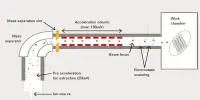Electrostatic voltmeter can refer to either an electrostatic charge meter, also known as a surface DC voltmeter, or a voltmeter used to measure high electrical potentials, also known as an electrostatic voltmeter. It is a device that uses electrostatic principles to measure electrical potential difference or voltage. It is based on the interaction of electric charges and fields.
Electrostatic voltmeters are available in both mechanical and electronic versions. Mechanical electrostatic voltmeters measure the force between the plates using a mechanical balance or torsion system. Electronic electrostatic voltmeters, on the other hand, measure force or voltage using solid-state components such as operational amplifiers and capacitance-to-voltage conversion circuits.
Charge meter
A surface DC voltmeter is a device that measures voltage without transferring any electric charge. It can measure surface potential (voltage) on materials without making physical contact, so there is no electrostatic charge transfer or voltage source loading.
An electrostatic voltmeter is made up of two parallel metal plates separated by a small air gap. One plate is typically grounded or connected to a reference potential, while the other plate is connected to the object or point where the voltage is being measured. The voltage to be measured creates an electric field between these plates, forming a capacitor.
Explanation
Many voltage measurements are impossible to perform with conventional contacting voltmeters because they require charge transfer to the voltmeter, which causes loading and changes to the source voltage. When measuring voltage distribution on a dielectric surface, for example, any measurement technique that requires charge transfer, no matter how small, will alter or destroy the actual data.
When a voltage is applied, the electric field causes the charges in the plates to redistribute. The movement of charges between the plates produces an attractive force that can be measured and related to the applied voltage. Typically, this force is measured mechanically or electronically.
Principle of operation
In practice, an electrostatic charge monitoring probe is placed close to the surface to be measured (1 mm to 5 mm), and an electronic circuit drives the probe body to the same potential as the measured unknown. This results in a high-accuracy measurement that is almost impervious to variations in probe-to-surface distances. When measuring high voltages, the technique also prevents arcing between the probe and the measured surface.
Electrostatic voltmeters are distinguished by their high input impedance, which means that they draw very little current from the circuit under test. This makes them useful for measuring voltages in sensitive electronic circuits without affecting the circuit’s operation significantly.
















